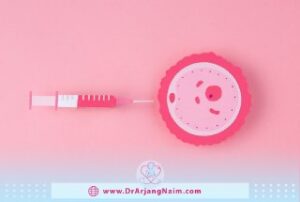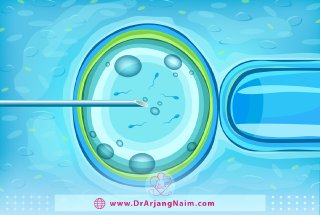In vitro fertilization is a fertility treatment in which eggs are combined with sperm outside the body in a laboratory. This is a method used by people who need help getting pregnant. IVF involves many complex steps and is an effective form of assisted reproductive technology (ART).
What is IVF?
In vitro fertilization is assisted reproductive technology in which sperm and eggs are fertilized outside the human body. IVF is a complex process that involves retrieving eggs from the ovaries and manually combining them with sperm in a laboratory for fertilization. A few days after fertilization, the egg is placed inside the uterus. Pregnancy occurs when the embryo implants itself in the uterine wall.

Why is in vitro fertilization performed?
IVF helps people with infertility who want to have children. Because it is expensive and invasive, couples often try other fertility treatments first. Infertility cases that may require IVF include:
- Uterine fibroids: Fibroids are benign tumors of the uterus. They are most common in women in their 30s and 40s. Fibroids can interfere with the implantation of a fertilized egg.
- Male infertility: Lower-than-average sperm concentration, poor sperm motility, or abnormalities in sperm size and shape can make it difficult for sperm to fertilize an egg.
- Blocked or damaged fallopian tubes: Damage or blockage of the fallopian tube makes it difficult for the egg to be fertilized or the embryo to move to the uterus.
- Endometriosis: Endometriosis occurs when tissue similar to the lining of the uterus implants and grows outside the uterus, often affecting the function of the ovaries, uterus, and fallopian tubes.
- Ovulation disorders: If ovulation is infrequent or absent, fewer eggs are available for fertilization.
- Unexplained infertility: Unexplained infertility means that no reason for infertility has been found despite evaluation for common causes.
- Reduced fertility in women over the age of 40
Parents may choose In Vitro Fertilization if they risk passing a genetic disorder to their children. A medical laboratory can test embryos for genetic abnormalities. Then, the doctor implants only embryos without genetic defects.
How long is the IVF process from start to finish?
IVF is a complex process with many steps. On average, you can expect this process to take four to six weeks. This includes the time before egg retrieval when a person takes fertility medication until they are tested for pregnancy.
Prepare for in vitro fertilization
Before starting IVF, women first undergo an ovarian reserve test. This involves taking a blood sample and testing it for follicle-stimulating hormone (FSH) levels. The results of this test give the doctor information about the size and quality of the eggs.
The doctor will also examine the uterus. This involves an ultrasound, which uses high-frequency sound waves to create an image of the uterus. The doctor also examines the vagina and the inside of the uterus. These tests can show the health of the uterus and help the doctor determine the best way to implant the embryo.
Men should do a sperm test. This involves giving a sample of semen, which the laboratory analyzes for the number, size, and shape of sperm. If the sperm is weak or damaged, an intracytoplasmic sperm injection (ICSI) may be necessary. During ICSI, a technician injects sperm directly into the egg. ICSI can be part of the IVF process.
Vitro fertilization performed
There are five stages in In Vitro Fertilization:
- Stimulation
- Egg retrieval
- Insemination
- Embryo culture
- Transfer
- Stimulation
A woman normally produces one egg during each menstrual cycle. However, IVF requires multiple eggs. Using multiple eggs increases the chances of developing a viable embryo. Fertility drugs are prescribed to increase the number of eggs the body produces. During this time, the doctor will perform regular blood tests and ultrasounds to monitor egg production and let the doctor know when to retrieve them.
Egg retrieval
Egg retrieval is known as follicular aspiration. This is a surgical procedure that is performed under anesthesia. The doctor uses an ultrasound wand to guide the needle through the vagina into the ovary and the egg follicle. The needle removes the eggs and fluid from each follicle.
Insemination
The man must now provide a semen sample. A technician mixes sperm with eggs in a petri dish. If it does not produce an embryo, the doctor may use ICSI.
Embryo culture
The doctor checks the fertilized eggs to ensure they are dividing and growing. Embryos may be tested for genetic conditions at this time.
Transfer
Once the embryos are big enough, they can be implanted. This usually occurs three to five days after conception. Implantation involves inserting a thin tube called a catheter into the vagina or cervix. Then the doctor releases the fetus into the uterus. Pregnancy occurs when the embryo implants itself in the uterine wall. This can take 6 to 10 days. A blood test will determine if you are pregnant or not.

Side effects
Some experience side effects from fertility medications used in the ovulation stimulation phase of IVF. This includes:
- Nausea and vomiting
- Hot flashes
- Headaches
- Enlargement of their ovaries
- Abdominal pain
- Bruising from IVF injections
After the embryo transfer, the woman should be able to resume her normal activities. The ovaries are enlarged and may cause some discomfort. Common side effects after embryo transfer includes:
- Constipation
- Bloating
- Cramping
- Breast tenderness
- Spotting
Risks
Doing IVF has risks.

Multiple births
IVF increases the risk of multiple births if more than one embryo is transferred to the uterus. Pregnancy with multiple fetuses carries the risk of premature birth and low birth weight compared to a single fetus.
Premature delivery and low birth weight
In vitro fertilization slightly increases the risk of a premature or low birth weight baby.
Ovarian hyperstimulation syndrome
Using injectable fertility drugs, such as human chorionic gonadotropin (HCG), to stimulate ovulation can cause ovarian hyperstimulation syndrome, in which the ovaries become swollen and painful.
Symptoms usually last a week, including mild abdominal pain, bloating, nausea, vomiting, and diarrhea. In the case of pregnancy, the symptoms may last for several weeks. Rarely, a more severe form of ovarian hyperstimulation syndrome may develop, which can cause rapid weight gain and shortness of breath.
Miscarriage
The miscarriage rate for women who conceive using IVF with a new embryo is similar to women who conceive naturally, about 15% to 25%, but this rate increases with maternal age.
Egg-retrieval procedure complications
Using an aspiration needle to collect eggs may cause bleeding, infection, or damage to the bowel, bladder, or blood vessels. There are also risks when used with sedation and general anesthesia.
Ectopic pregnancy
About 2 to 5 percent of women who use IVF will have an ectopic pregnancy. The fertilized egg cannot survive outside the uterus, and there is no way to continue the pregnancy.
Birth defects
Maternal age is the most important risk factor for birth defects, regardless of how the baby was conceived. More research is needed to determine whether babies conceived using IVF may be at increased risk of certain birth defects.
Cancer
Although some early studies suggest that there may be a link between certain medications used to stimulate egg growth and the development of certain types of ovarian tumors, more recent studies have not confirmed these findings. There does not appear to be a significant increase in the risk of breast, endometrial, cervical, or ovarian cancer after IVF.

Stress
Using IVF can be financially, physically, and emotionally draining. The support of counselors, family, and friends helps couples through the ups and downs of infertility treatment.
Results
About 12 days to two weeks after egg retrieval, the doctor will test a sample of the mother’s blood to determine if pregnancy has occurred.
If pregnancy has not occurred, the use of progesterone is stopped, and the woman will probably have her period within a week. If the couple is interested in doing another cycle of in vitro fertilization (IVF), the doctor may suggest measures to improve the chances of conceiving through IVF.The chance of having a healthy baby after IVF depends on several factors.
Maternal age
The younger the mother is, the more likely she is to get pregnant and give birth to a healthy baby using her eggs during IVF. Women 41 and older are often advised to use donor eggs during IVF to increase their chance of success.
Embryo status
Transferring more developed embryos is associated with higher pregnancy rates than less developed embryos. However, not all embryos survive the development process.
Reproductive history
Women who have given birth before are more likely to get pregnant using IVF than women who have never given birth. The success rate is lower for women who had previously used IVF but did not conceive.
Cause of infertility
Having a natural egg source increases the chances of getting pregnant using IVF. Women with severe endometriosis are less likely to get pregnant using this method than women with unexplained infertility.
Lifestyle factors
Women who smoke usually retrieve fewer eggs during IVF and may have more miscarriages. Smoking can reduce a woman’s chance of success using In Vitro Fertilization by up to 50%. Obesity can reduce the chances of getting pregnant and having a baby. Alcohol use, recreational drugs, excessive caffeine, and certain medications can also be harmful.
What medications are used for IVF?
Several medications can be used during an IVF cycle. Some are taken orally, while others are injected, absorbed through the skin, or inserted into the vagina. The healthcare provider will determine the exact dosage and timing depending on the treatment plan.
Follicle-stimulating hormone (FSH)
These hormones act to stimulate the ovaries to produce eggs. One or a combination of both may be given during treatment. This is done for approximately 14 days.
Human chorionic gonadotropin (hCG)
It is usually given as one final shot to stimulate the eggs to mature and start ovulation.
Leuprolide acetate
It is a gonadotropin-releasing hormone (GnRH) (response initiator) agonist administered by injection. It can help control the firing process or be a trigger shot.
Birth control pills or injections may be prescribed before starting IVF. This provides a level of cycle control and allows all eggs to start simultaneously. Most people are given estrogen supplements before and after the embryo transfer. This hormone helps to thicken the lining of the uterus. Progesterone is also added to improve the chances of the embryo implanting and developing into a successful pregnancy.
The bottom line
The inability to get pregnant after one year of intercourse is called infertility. Today, there are various methods to treat infertility. The cause of infertility in men and women is different.
The most common method of assisted reproduction is IVF or in vitro fertilization. This method is the oldest and most effective method among assisted reproductive methods.
Deciding whether to have IVF and how to try if the first attempt fails is incredibly complex. This process’s financial, physical, and emotional toll can be difficult.
Additional questions
- What can be done to increase the chances of pregnancy with IVF?
Several factors can determine the success of IVF, some are controllable, and some are not. These factors include:
- Age
- Height and weight
- The number of previous births
- Total number of pregnancies
- Using your eggs or donor eggs
- Number of IVF cycles
- The success rate of the fertility clinic
- Health conditions
- Your cause of infertility
- What is the best age to get IVF?
Research shows that the chances of getting pregnant or having a live birth after IVF treatment decrease starting at age 35. The success rate drops significantly after the age of 40.
- Can you choose the gender during IVF?
Yes, it is possible to choose the sex of the baby during IVF. Before the embryo is implanted in the uterus, the embryo’s cells can be checked for male or female chromosomes. Couples can implant only the desired sex and discard the other embryos.
- Are IVF pregnancies high-risk?
An IVF pregnancy is not automatically considered high-risk. An IVF pregnancy is considered high-risk if medical conditions put the mother at risk. For example, the old age of the mother, expecting multiples or high blood pressure.
- What is Intrauterine insemination (IUI)?
Intrauterine insemination (IUI) is a type of artificial insemination, a method of infertility treatment. The washed and concentrated sperm are placed in the uterus at exactly the time the ovary releases one or more eggs for fertilization.
References
https://www.mayoclinic.org/tests-procedures/in-vitro-fertilization/about/pac-20384716
https://medlineplus.gov/ency/article/007279.htm
https://www.plannedparenthood.org/learn/pregnancy/fertility-treatments/what-ivf
https://my.clevelandclinic.org/health/treatments/22457-ivf
https://www.healthline.com/health/in-vitro-fertilization-ivf#outlook
https://www.webmd.com/infertility-and-reproduction/guide/in-vitro-fertilization
https://americanpregnancy.org/getting-pregnant/infertility/in-vitro-fertilization/




